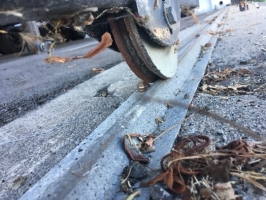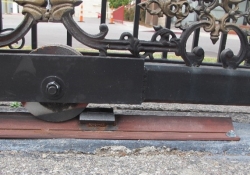DEFECTIVE GATE DESIGNS
PERSONAL INJURY & WRONGFUL DEATH

Download PDF of this article here
By Michael Panish, Door & Gate Expert Witness
Sliding and swinging gates that move are attached to fixed panels or walls that make up the perimeter boundary of a property. In this article I am discussing defective sliding gates that have resulted in life threatening injuries and wrongful deaths.
Gate injuries are often caused by improper design and fabrication. From the very inception of a new gate project, an improperly crafted gate is inherently the beginning of a future serious injury or even deadly claim. In every automatic operator installation manual that I have ever seen and used, there is the basic requirement that prior to installation the gate should be properly configured and working correctly in the manual mode. If the gate design and function is unsafe prior to automation, it is not going to be functioning safer after an automatic operator is installed. It is below the industrywide standard of care to attempt to depend upon an automated operator to limit the path of travel of an improperly configured manual gate. It is not acceptable to allow an operator to overpower and move a binding gate that has defectively operating components needing replacement.
 Most of the injury claims that involve sliding gates falling onto pedestrians
are the direct result of an original failure to install adequate restrictors
or, through lack of inspection and maintenance, original components are
bent out of alignment, broken, or completely missing. The design intent
and the purpose of perpendicular intersecting metal stops are to keep
the sliding mechanism from exceeding the upright enclosure. I have seen
installations where there are no upright corrals that need to be in place
to maintain the sliding gate in an upright and secure position. When gate
stops are broken or missing, the full length of the gate can be pulled
past the fixed corral that is supposed to keep the gate in an attached
and upright position when the gate has over-traveled.
Most of the injury claims that involve sliding gates falling onto pedestrians
are the direct result of an original failure to install adequate restrictors
or, through lack of inspection and maintenance, original components are
bent out of alignment, broken, or completely missing. The design intent
and the purpose of perpendicular intersecting metal stops are to keep
the sliding mechanism from exceeding the upright enclosure. I have seen
installations where there are no upright corrals that need to be in place
to maintain the sliding gate in an upright and secure position. When gate
stops are broken or missing, the full length of the gate can be pulled
past the fixed corral that is supposed to keep the gate in an attached
and upright position when the gate has over-traveled.
On the right: Example of a gate improperly fabricated with no perpendicular stop installed at the top that allowed the gate to travel past the desired stop and fall.
There are usually at least two components that are observed to be missing or defective regarding gate stops. One is the absence of any restricting stop component, the other are missing or broken pinch rollers that are used to guide and align the sliding gate as it opens and closes.
In some poorly maintained installations where perpendicular restrictors are installed, they have not been fabricated to be long enough or high enough to stop the gate from over-travelling.
They are often found to be rotted or so thoroughly rusted that they fall apart when they are impacted. In many inspections, I have seen weld mark locations where a gate stop was originally located but was completely missing at the time of the injury incident. In other inspections, it has been discovered that the material used to stop the gate travel had shifted out of the appropriate location and the pinch rollers were broken allowing the gate to pass the potential stop position and fall on an unsuspecting user.
The photos below show 1. Typical surface mount V-Track 2. Sliding gate wheel with mating grooved slot to follow V-Track (note adjacent debris which can cause derailment 3. In ground recessed V-Track w/ rocks & pebble debris that caused front wheel to derail.



Another common defect that leads to serious gate injuries are the methods that convey the gate. There are at least a couple of common installations that rely upon rolling wheels to direct and attach the gate to the fixed fence portion of the enclosure. One typical type of rolling installation utilizes an inverted V-shaped steel track that is implanted under the path of the sliding gate.
On the leading and trailing edges of the moving gate, the bottom corners of the gate have a mating V-shaped roller that rides upon the inverted track.
In most installations the rollers are steel or aluminum. I have also observed nylon or plastic rollers. With any V-track installation there are a few ongoing maintenance issues that need to be followed. The roller must be checked for function, lubrication, and attachment. There is usually an axle that is centered on the hub of the roller wheel that runs through some sort of bearing. If the bearing wears through usage or abuse, the axle often is no longer centered or concentric, and the wheel will not travel smoothly and consistently. If there is no bearing and only a hole in the center of the guide wheel, the hole can become ovalized and the axle will not maintain true alignment, causing the wheels to hump or bind as the gate is moved open and closed, often falling off of the V-track. Further maintenance is required for an above ground V-track installation. The track must be checked for full attachment to the pavement where it is positioned. Whether it is recessed or surface mounted, the entire length of the track must be constantly checked for any materials that would cause a derailment. These obstructions can include rocks, pebbles, trash, or other debris that can affect the connection between the roller and track.
Another type of sliding gate attachment relies upon a series of horizontal poles attached to the fixed portion of the fencing. They typically have multiple wheels riding upon them that allow the sliding gate to travel.
Multiple wheels attached to the sliding gate need to be routinely inspected for alignment, lubrication, and that they are in a stable fixed location so that the sliding gate does not bind or fall off of the horizontal railings. This type of conveyance system also requires a positive vertical corral and proper perpendicular stop to maintain the sliding gate in an upright position. Depending upon the weight and size of the sliding gate, the horizontal rail system is often augmented with a pair of rubber rolling wheels on the leading edge.
These rolling wheels take a portion of the sliding gate weight and need to be properly maintained for alignment so that the gate travels in a straight line.

Many gate injuries have occurred when a service provider installs an automatic operator but fails to evaluate and recognize that the gate is improperly configured as a manual gate prior to their work. Gates are often missing required stops and properly designed vertical corrals. Ignorant or careless service providers automate the gate system without concern. They install the gate operator and create an extremely dangerous condition by relying upon the stop mechanism of the operator to control the movement limits of travel of the sliding gate. These limits are either electronic or manually adjusted to allow the gate to open and close without any protection from the missing fabricated perpendicular stops or vertical corrals.

Over the course of time, without appropriate inspections or maintenance,
the sliding gate travel limits that were originally determined by the
operator installer can drift electronically or mechanically break due
to age, usage, or abuse. This allows the gate operator to continue to
operate and move the sliding gate past the point where it is no longer
attached to the fixed part of the fence. This often pushes or pulls the
sliding gate into a location where it falls upon a pedestrian or vehicular
user that is unaware of the defective condition of the gate.
In some cases, users that are not trained or have any understanding of
the dangerous condition that exists attempt to operate and or make adjustments
to the gate operator so that they can continue to use the opening. They
have endangered themselves by failing to obtain the services of a competent
professional service provider who would make required repairs, because
of their ignorance or in a foolish effort to save operating expenditures.
Some gate operators rely upon chains to drive the sliding gate system. Others rely upon the compression of components between directly driven pinch rollers or mechanical sliding mechanisms. Most gate operators manufactured after the year 2000 were built to be compliant with UL 325 (Underwriters Laboratories) entrapment protection standards. When a manual sliding gate system is incorrectly fabricated and is missing protective positive mechanical stops, the addition of an automated operator with all compliant UL 325 safety features offers no protection for any user and often increases the danger associated with the defectively fabricated sliding gate.
Mike Panish is a nationally recognized gate expert that is retained evenly for plaintiff and defense legal claims. He is currently the retained gate expert witness on numerous gate personal injury and wrongful death claims across the United States. He is extremely knowledgeable of the required standards and installation parameters that affect gate safety. He is routinely called upon by major product manufacturers to analyze injury claims from an independent and unbiased perspective. He is well known, highly respected, and is established as the industry expert of choice. He has provided his services for wrongful death, personal injury, and property damage claims and he has authored numerous articles pertaining to automatic gate safety and related injuries including gate operation and automated gate parking control arm systems. For a complete list of all of his expert services, areas of expertise, and published articles visit his website at www.constructionwitness.com. For additional information or to discuss your specific case needs, contact Mr. Panish’s office at (888) 902-4272 (Sharon), www.ConstructionWitness.com.



